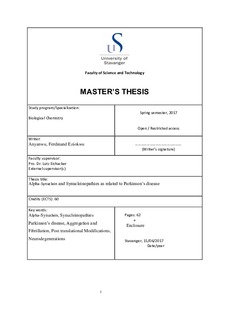| dc.contributor.advisor | Eichacker, Lutz | |
| dc.contributor.author | Anyanwu, Ferdinand Eziokwu | |
| dc.date.accessioned | 2017-09-29T13:15:04Z | |
| dc.date.available | 2017-09-29T13:15:04Z | |
| dc.date.issued | 2017-06-15 | |
| dc.identifier.uri | http://hdl.handle.net/11250/2457543 | |
| dc.description | Master's thesis in Biological chemistry | nb_NO |
| dc.description.abstract | Parkinson’s disease (PD) is a chronic, progressive, complex, age-related and movement neurodegenerative disorder, caused by the loss of dopaminergic neurons in a small portion of cells within the mid brain known as the substantia nigra, with its actual etiology undiscovered. Alpha-Synuclein (a-Syn), a minute soluble protein that is primarily expressed at the presynaptic terminal or regions of the central nervous system with a yet unknown function is termed the central or key component to the pathogenesis of this disorder. Thus, Parkinson’s disease is the most commonly diagnosed and observed synucleinopathies. Alpha-Synucleinopathies are neurodegenerative disorders featured by the aberrant accretion or deposition of aggregates of alpha-synuclein in the neurons, glial cells or nerve fibres. There are three main types of synucleinopathies; Parkinson’s disease (PD), Dementia with Lewy bodies (DLB) and Multiple system atrophy (MSA). Not minding the similarities in their progressions and expansion, there are pathological differences that are significant between multiple system atrophy and Lewy body diseases, along with the cell types that are involved (in Parkinson’s disease, oligodendroglia in Multiple System Atrophy and Dementia with Lewy bodies) and the extent of neuronal loss in selected regions in Parkinson’s disease but spread all over the regions in Multiple System Atrophy.
Alpha-synuclein, as abundantly found in various regions of the brain, having two intimately related homologs; Beta-synuclein and Gamma-synuclein, was recognised as the dominant component of amyloid fibrils observed in Lewy bodies and Lewy neurites which are the diagnostic hallmark of Parkinson’s disease. Aggregation of alpha-Synuclein is assumed to be the key or major event in the pathogenesis of synucleinopathies. Although, several alpha-Synuclein reformations and modifications have been thought to be responsible for early steps of aggregation.
In this thesis work, I will be able to summarize and review the data so far available on Alpha-synuclein, its structure, aggregation and fibrillation, the modifications and synucleinopathies. | nb_NO |
| dc.language.iso | eng | nb_NO |
| dc.publisher | University of Stavanger, Norway | nb_NO |
| dc.relation.ispartofseries | Masteroppgave/UIS-TN-IMN/2017; | |
| dc.rights | Navngivelse 4.0 Internasjonal | * |
| dc.rights.uri | http://creativecommons.org/licenses/by/4.0/deed.no | * |
| dc.subject | biological chemistry | nb_NO |
| dc.subject | biologisk kjemi | nb_NO |
| dc.subject | alpha-synuclein | nb_NO |
| dc.subject | synucleinopathies | nb_NO |
| dc.subject | Parkinson's disease | nb_NO |
| dc.subject | aggregation and fibrillation | nb_NO |
| dc.subject | post-translational modification | nb_NO |
| dc.subject | neurodegenerations | nb_NO |
| dc.title | Alpha-Synuclein and synuceinopathies as related to Parkinson's disease | nb_NO |
| dc.type | Master thesis | nb_NO |
| dc.subject.nsi | VDP::Matematikk og Naturvitenskap: 400::Basale biofag: 470::Biokjemi: 476 | nb_NO |

